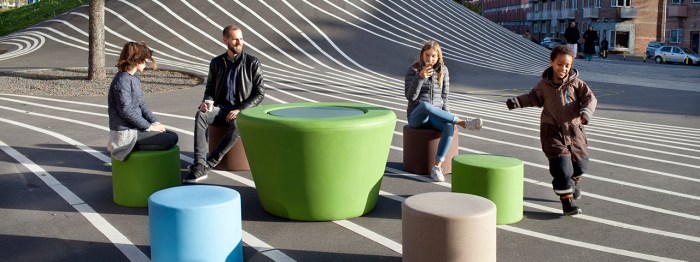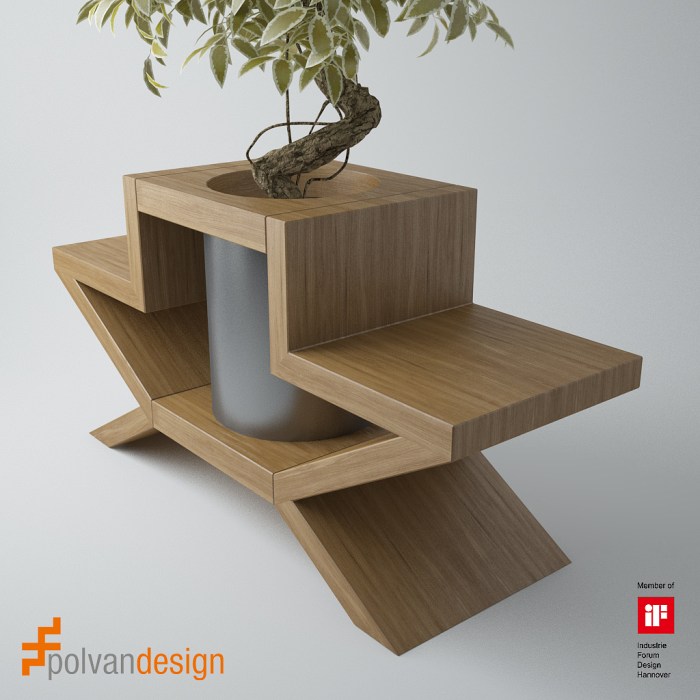Urban furniture sets the stage for a captivating exploration of how thoughtfully designed public spaces enhance city life. From benches and bus shelters to innovative lighting and interactive installations, these seemingly mundane objects significantly impact urban experiences. This discussion will delve into the multifaceted role of urban furniture, considering its aesthetic, functional, and social contributions to the urban environment.
We’ll examine various design considerations, including materials, durability, accessibility, and the integration of urban furniture into broader urban planning strategies. The impact of sustainable practices and innovative technologies in the creation and maintenance of urban furniture will also be explored, highlighting the importance of balancing functionality with environmental responsibility.

Urban living often presents challenges when it comes to creating comfortable and aesthetically pleasing outdoor spaces. Limited square footage and shared environments necessitate creative solutions. This is where urban furniture steps in, offering a range of stylish and functional pieces designed specifically for smaller spaces and urban settings. This comprehensive guide explores the world of urban furniture, delving into its various types, materials, styles, and considerations for successful integration into your urban landscape.
Understanding Urban Furniture: More Than Just a Bench
Urban furniture transcends the simple notion of park benches. It encompasses a wide array of elements designed to enhance the functionality and aesthetic appeal of urban environments. This includes, but is not limited to:
- Street Furniture: This category includes items like benches, bus shelters, litter bins, bike racks, and bollards – all essential components of a well-functioning city.
- Park Furniture: Similar to street furniture but often with a greater emphasis on comfort and leisure, featuring picnic tables, swings, play structures, and decorative elements.
- Balcony & Patio Furniture: Designed for smaller spaces, this includes compact tables, chairs, sofas, and storage solutions optimized for balconies, patios, and rooftop gardens.
- Public Space Furniture: This encompasses a broader range, including seating areas in plazas, parks, and public squares, often incorporating artistic and community-focused designs.
Key Considerations When Choosing Urban Furniture
Selecting the right urban furniture requires careful consideration of several factors:

- Space Constraints: Measure your available space meticulously. Opt for furniture with a compact footprint to maximize usability.
- Durability and Weather Resistance: Urban furniture faces harsh weather conditions. Choose materials that can withstand rain, sun, and temperature fluctuations. Powder-coated steel, aluminum, and weather-resistant wicker are popular choices.
- Material Selection: Consider the aesthetic and practical aspects of different materials. Recycled materials are increasingly popular, promoting sustainability.
- Maintenance Requirements: Some materials require more maintenance than others. Choose furniture that aligns with your lifestyle and available time for upkeep.
- Style and Aesthetics: Select furniture that complements the overall style of your urban space and personal preferences. Modern, minimalist, rustic, or traditional styles are all readily available.
- Safety and Accessibility: Ensure the furniture is safe and accessible for all users, including those with mobility limitations. Consider features like armrests, ergonomic designs, and sturdy construction.
- Budget: Urban furniture prices vary widely depending on materials, design, and brand. Set a realistic budget before starting your search.
Popular Materials for Urban Furniture
The choice of materials significantly impacts the durability, aesthetics, and maintenance requirements of your urban furniture. Here’s a closer look at some popular options:
- Steel: Durable and strong, steel furniture can withstand heavy use and harsh weather conditions. Powder-coated finishes enhance its weather resistance and aesthetic appeal. However, it can be heavy and susceptible to rust without proper coating.
- Aluminum: Lighter than steel, aluminum is also highly durable and weather-resistant. It’s often used in more contemporary designs and requires minimal maintenance.
- Wicker: Provides a more natural and relaxed aesthetic. Synthetic wicker is particularly durable and weather-resistant, while natural wicker requires more care and protection from the elements.
- Wood: Offers a classic and warm aesthetic, but requires regular maintenance to protect it from weathering and pests. Hardwoods like teak are more durable and weather-resistant than softwoods.
- Concrete: A highly durable and low-maintenance option, concrete furniture offers a modern and industrial look. However, it can be heavy and may require professional installation.
- Recycled Materials: Increasingly popular, recycled plastic, wood, and metal contribute to sustainability and offer unique design possibilities.
Urban Furniture Styles and Trends
Urban furniture reflects evolving design trends, offering a diverse range of styles to suit various tastes and environments:

- Modern Minimalist: Clean lines, simple forms, and neutral colors characterize this style, emphasizing functionality and practicality.
- Industrial Chic: Combines raw materials like metal and wood with a focus on functionality and a slightly rough-hewn aesthetic.
- Rustic Charm: Emphasizes natural materials like wood and wicker, creating a warm and inviting atmosphere.
- Contemporary: Blends modern and traditional elements, often incorporating bold colors and unique designs.
- Sustainable Design: Prioritizes eco-friendly materials and manufacturing processes, reflecting a growing awareness of environmental concerns.
Where to Buy Urban Furniture
Urban furniture is available from a variety of sources, both online and offline:
- Online Retailers: Offer a wide selection and convenient shopping experience, but may require careful consideration of shipping costs and return policies.
- Specialty Furniture Stores: Often carry higher-quality and more unique pieces, but may be more expensive.
- Home Improvement Stores: Provide a more budget-friendly option, but may have a more limited selection.
- Local Artisans and Designers: Offer bespoke and custom-made pieces, allowing for greater personalization and unique designs.
Frequently Asked Questions (FAQ)
- Q: How do I clean my urban furniture? A: Cleaning methods vary depending on the material. Consult the manufacturer’s instructions for specific cleaning recommendations.
- Q: How can I protect my urban furniture from the elements? A: Use protective covers during harsh weather conditions. Regular cleaning and maintenance also help prolong the lifespan of your furniture.
- Q: What are the best materials for outdoor urban furniture? A: Weather-resistant materials like powder-coated steel, aluminum, and synthetic wicker are excellent choices.
- Q: How do I choose the right size and style of urban furniture for my space? A: Measure your space carefully and consider your personal style and the overall aesthetic of your urban environment.
- Q: Where can I find inspiration for urban furniture design? A: Browse online design magazines, websites, and social media platforms for ideas and inspiration.
References
Call to Action
Ready to transform your urban space? Start exploring the world of urban furniture today and create an outdoor oasis that reflects your unique style and needs. Browse our selection of high-quality, durable, and stylish urban furniture now!
FAQ Corner
What materials are commonly used in urban furniture?
Common materials include steel, concrete, wood, recycled plastic, and composite materials. The choice depends on factors like durability, maintenance, and aesthetic considerations.
How is urban furniture maintained?
Maintenance varies depending on the material and design. Regular cleaning, repairs, and occasional replacements are necessary to ensure functionality and safety.
What role does accessibility play in urban furniture design?
Accessibility is crucial. Designs must adhere to ADA guidelines, ensuring usability for people with disabilities, including features like appropriate seating heights and armrests.
